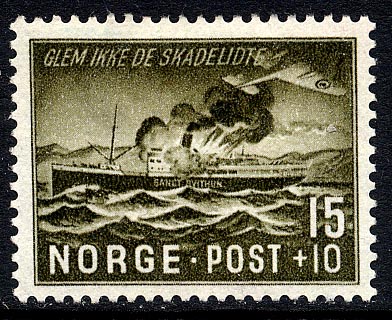She was built as a cargo- passenger vessel by The International Shipbuilding & Engineering Co. Ltd. (Danziger Werft), Danzig for Det Stavangerske Dampskibselskab, Stavanger, Norway.
Launched under the name SANCT SVITHUN.
Tonnage 1.376 gross, 778 net, 734dwt., dim. 236.0 x 35.2 x 21.3ft.
Powered by a 4-cyl Lentz-type double compound engine, manufactured by the Danziger Werft, 1.650 ihp., speed 14 knots.
01 July 1927 delivered to owners.
Copied from
http://warsailors.com/homefleet/shipss1.html
After delivery used in the Hurtigruten service from Bergen to North Norway.
1931 Fitted out with refrigerated hold for the transport of fresh fish, and a radiotelegraphy installation.
When war broke out between Germany and Norway in 1940 she was for her yearly docking at the Klaseskjaer yard in Stavanger, but took up her service again in the summer.
She was under command of Captain Samuel Alshager from 1928, and under his command on 30 September 1943 she sailed between Vossa and Bukholmen near Stadt, on a southward bound voyage in heavy weather when at around 19.00 she was attacked by machine gun fire and bombs from six British aircraft.
She received several direct hits and was set ablaze. The captain and the pilot attempted to beach her on the west side of Kobbeholmen (off Ervik), and were able to place her bow on a submerged rock, but the stern part was sinking in the heavy swells. Her entire midship section was on fire and the heat was intense. People at Ervik, who were busy harvesting potatoes in the field’s saw what was happening, and ran to their boathouses wanting to help.
12 people in 3 large rowboats headed towards the ship and were able to save several from the water, as well as from a raft.
One of the SANCT SVITHUN’s able seamen jumped into the sea and with great difficulty managed to climb up on Kobbeholmen where he fastened the hawser, which was then used by many people to get to safety. They in turn were rescued by the rowboats; as soon as there was a break in the high swells, a couple of people would jump from the steep knoll and into one of the boats.
After a while SANCT SVIHUN slid off the rock and sank. The rescue operation continued until it turned dark, and about 20 survivors had to spend the night there, until other, smaller boats returned early the following morning to pick up the rest of the cold, shipwrecked people. The last person to be rescued was the captain, who had also been the last to leave the ship. Later that day it became clear that 78 or 79 had been saved, while 24 Norwegian passengers, 19 crew and between 10 and 20 German soldiers died.
(Numbers vary according to source – another sources gives; 22 0r 26 passengers died, as well as 10 – 12 Germans.
A possible reason for the bombing of SANCT SVITHUN could be that she had had 50 German soldiers on board at first. However these had disembarked when she arrived Ålesund earlier that day (they traveled later south on board the HAVDA.)
The wreck is in a depth of 5 – 30 meters today. The ship bell is hanging in the tower of the church at Ervik. Det Stavangerske D/S saw to it that it got the following inscription:
“To the people of Ervik, in acknowledgement of their saving lives in connection with the loss of SANCT SVITHUN on September 30- 1943”.

